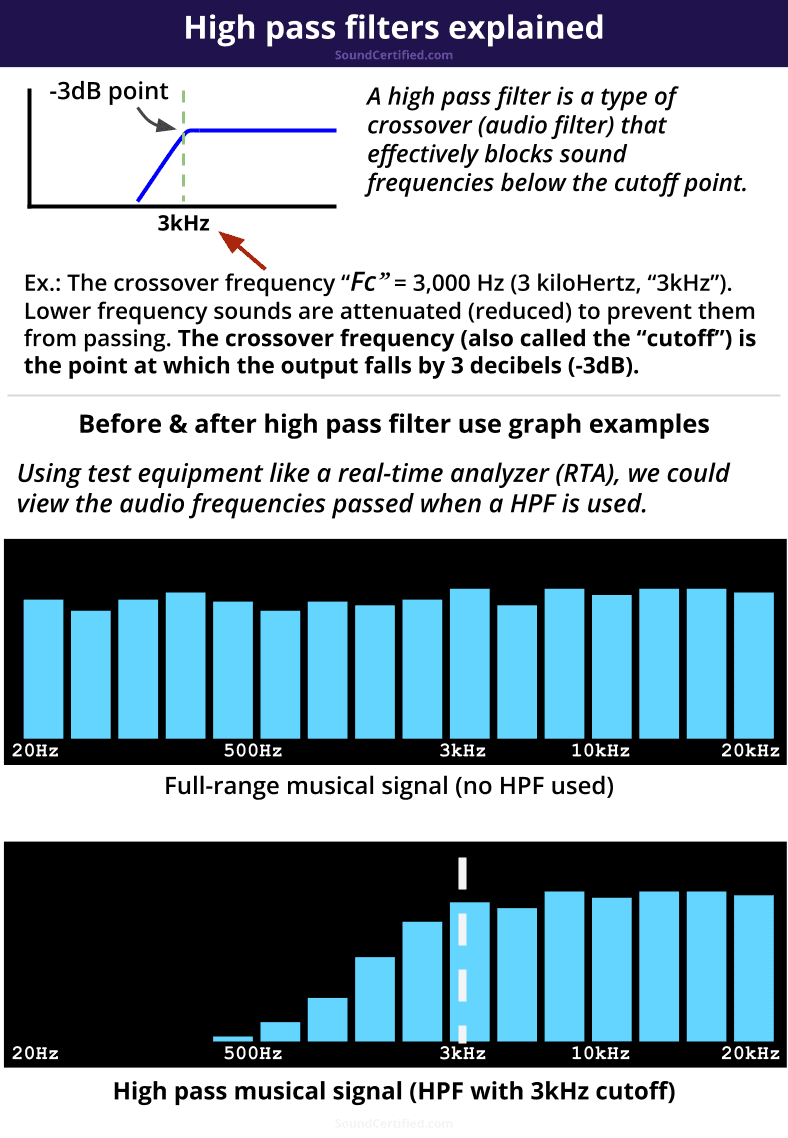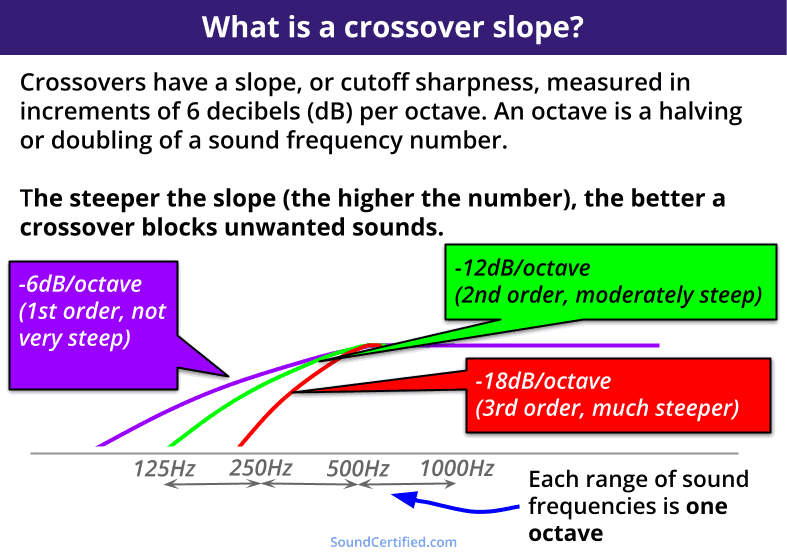When it comes to getting good sound, crossover filters are incredibly helpful. But what is a high pass filter audio crossover and why are they so important?
I’ll explain it all here!
Contents
What is an audio high pass filter?
The basic answer is that an audio high pass filter (HPF) is a type of audio crossover that attenuates and effectively blocks all low frequency signals below a set point. That is, they eliminate low frequency audio while passing high frequency signals to amplifiers, speakers, signal paths, or other audio components.
They’re widely used in a variety of audio designs to block an unwanted sound frequency range for several reasons:
- Preventing distortion
- To protect tweeter speaker drivers from becoming damaged
- To get more volume and clarity from small speakers by blocking subwoofer bass
- Working as part of a 2-way or 3-way speaker system
- Preventing resonance problems by limiting the lower frequency range, thereby preventing a speaker’s resonant frequency from being reached
There are some other useful high pass filter applications to know about, too. There 3 main types of high pass filter design types as you’ll see.
High pass filter vs low pass filter differences
While a highpass filter allows higher frequencies to pass, a low pass filter (LPF) crossover works to block high frequency sounds above the cutoff frequency.
These are often used for woofers and subwoofers but can also be used as part of a 2-way speaker design. A HPF filter would be used for the tweeter portion of the design.
What is a band pass filter?
A band pass filter consists of both a low pass filter and high pass filter in series. This passes a middle range (passband) of sound frequencies.
They’re sometimes used as a part of 3-way speaker systems to supply a range of sound to midrange speaker drivers.
The three types of high pass crossovers
There are three types of high pass filter designs. Each has its particular uses, pros and cons, and applications.
1. Speaker crossovers (passive filters)
A speaker crossover (also called a passive filter) uses passive electronic components instead of electronics that require a power source. The passive components are capacitors, inductors, and resistors.
A high pass speaker crossover is very common on tweeter speakers where it blocks midrange and bass frequencies from reaching them. The simplest type is a single electrolytic capacitor mounted on the speaker itself.
Example of a capacitor used as an inline high pass filter crossover
Others use a capacitor and inductor for a steeper cutoff to more effectively block unwanted sounds from reaching a speaker. Most are hardwired and have minimal, if any, adjustable settings since the design is set by the fixed part values.
2. Electronic crossovers (active filters)
An electronic high pass filter, also called an active filter, is a type of crossover that uses small electronic components and requires a power source. Unlike passive filters, they’re often flexible and may offer additional settings such as:
- Adjustable high pass cutoff frequency
- Selectable crossover slope
- Gain control (adjustable input and/or output levels)
- Phase control
Most electronic high pass filters are designed around operational amplifiers (op amps) which are tiny transistor amplifiers built into an integrated circuit (IC). They’re very efficient in terms of power use, size, and features.
You’ll find active filter designs in home stereos, car amplifiers, preamp units, stereo mixer boards, and many other audio electronic products.
3. Digital (software based) crossovers
A digital high pass filter works on audio signals converted to digital values using mathematical functions in software before converting them back to an analog signal.
A digital crossover can be found in several platforms:
- Computer audio software (mixing, editing, and more)
- Digital signal processing (DSP) chips or audio products
- Smartphone audio apps
In all cases, a high pass filter audio crossover is implemented using mathematical functions (z transforms) that are coded in software routines. When a musical signal is applied the code processes the digital representation (binary numerical value), resulting in an output signal that’s greatly decreased below the crossover frequency.
Shown here is a digital low pass filter built into a Denon home stereo receiver. Digital crossovers work using software program code to provide a high pass function mathematically.
Digital crossovers are also used along with a graphic or parametric EQ in car audio head units, home stereo receivers, and audio processing & recording software.
Useful high pass filter applications
Microphone and recording studio use
High pass filters are useful in the recording studio in several ways:
- Removing plosives (pops) from singer or vocalist breath
- Preventing the recording of handling or rumbling sounds due to equipment being touched and adjusted
- Isolating audio sources from different instruments during recording
- Shaping the tonality of ranges of sound during mixing
- Blocking out background noise from recording tracks
High pass filter car audio benefits
In car audio systems, high pass filtering is found in a few items usually: built into car amplifiers, passive speaker crossovers, installation add-on accessories, and built into car stereos, equalizers (EQs), or signal processors.
They’re usually very helpful in delivering better sound in a number of ways:
- Preventing distortion or potential damage in tweeters due to bass
- Providing cleaner sound with more power both with tweeters and small speakers
- As part of a 2-way speaker system (example: component speakers)
- To block low end bass sound from the main speakers, leaving it to be handled by subwoofers for better sound clarity
These days some head units have digital high pass filters built in along with selectable slopes. Many car amplifiers have a selectable high or low-pass crossover function, with some having an adjustable cutoff frequency. Others have a fixed cutoff point that can’t be changed.
Tweeters and other small speakers simply can’t handle larger sound waves created by low bass frequencies. Even a budget system can sound great when powered by a decent quality amp with a high pass crossover preventing them from being sent to the speakers.
You can then pair them with a subwoofer and a low pass filter to get great full range sound you’ll enjoy.
Home stereo high pass filters
Home stereos often include high pass filter options for a variety of reasons:
- Subwoofer use: when a home theater system or stereo receiver has a subwoofer output, blocking bass to the main speakers can help prevent “muddiness” or too much bass being produced
- Some stereo systems include speakers that are limited in quality, meaning bass causes them to distort and sound poor. Using a high pass function in these cases helps prevent that.
- Built into surround sound home theater audio channel processing.
- To limit sound sent to a center channel speaker for clear vocals in movies.
Much like car stereo systems, home stereo high pass filters often aren’t turned on by default – you’ll need to check menu settings and enable them in many cases.
Subsonic filters explained
A subsonic filter is a high pass filter with a very low crossover frequency (often around 30 or 20Hz for example) used to prevent low frequency signals we can’t hear from being sent to a subwoofer prevent wasting power for no reason.
A subsonic filter is optional and not often needed but may be useful in some situations. They’re more common for vintage audio and record players, although you can sometimes find them in car audio equalizers or subwoofer bass items.
The human hearing frequency range for most people is somewhere down to just about 30Hz. 20Hz sound waves can be felt but not heard, so it’s pointless to draw a lot of amplifier power for something you can’t even hear. In the case of record players some rumble can be present and a subsonic filter can prevent this from being amplified.
Most music is mixed with the most enjoyable bass being around 40 to 50Hz or so for “thump”. It’s also about the same for rumbling or action sound in movies, meaning 20 to 30Hz isn’t needed.
Cutoff frequency attenuation (slopes) explained
Filter slope is the steepness of its filtering ability. In other words, it’s how effective it is at reducing sound frequencies beyond the crossover cutoff frequency.
Slopes are categorized in terms of decibels (dB) per octave. A negative sign (-) is used to represent an attenuation, or reduction, of the input signal.
Sound frequencies between two points are often measured using an octave. An octave is a doubling or halving of a frequency number. (100Hz, 200Hz, 400Hz, etc.)
When we refer to a crossover having a cutoff of -6dB per octave, we mean it will continue to reduce the output by an additional 6dB for every doubling of the previous frequency.
The greater the filter’s slope, the more it reduces lower frequencies beyond the cutoff frequency because a higher order filter is more effective.
Crossover filter slopes are typically 6dB per octave, 12dB/octave, 18dB/octave, and so on.
How to use a high pass filter
Generally speaking, using a high pass filter is simple: you set it to the cutoff frequency best suited to the speakers you’re using. In the case of 2-way speaker systems you’ll also set it to match the low pass cutoff frequency as well to avoid a gap in sound.
Speaker filter frequencies
When it comes to speakers and speaker systems, manufacturers often include specifications to help you know the cutoff frequency to use.
It’s sometimes clearly stated as the recommended high pass filter frequency while other times you’ll have to base it off of a speaker’s frequency response information. For example, in the speaker specifications image above the speaker has a usable frequency range of 3.5kiloHertz (kHz) and above.
If you don’t have any of that available refer to the tables I’ve provided below. The good news is that there’s usually some information to tell you a speaker’s frequency response range in order to help you set the high pass cutoff frequency.
What are some good HPF settings?
Home audio high pass crossover frequency table
| Speaker type/system | Crossover frequency |
|---|---|
| Main/tower type front speakers (small) | 60 to 80 Hz high-pass. Works best with a subwoofer to complement them. |
| Main/tower type front speakers (large) | 60-80Hz high-pass. |
| Center or surround sound (small) | 100-120Hz high pass. These types of speakers are very poor for bass and can distort easily. |
| Center or surround sound (medium/large) | 60-80Hz high pass. Most center speakers are not designed for bass production. |
| On-wall or mini satellite speakers | 100-120Hz high pass. This helps avoid bad distortion since they can’t handle deep bass. |
| 2-way speaker systems | 3kHz to 3.5KHz. Very common crossover frequency |
| 3-way speaker systems | 3.5kHz high pass (tweeter) & 250-500Hz high pass (midrange) |
Car audio high pass crossover frequency table
| Speaker type/system | Crossover frequency |
|---|---|
| Front or rear full-range coaxials or component speakers | 56, 60, to 80 Hz high pass. Blocks low end bass that causes distortion. |
| Tweeters | 3-3.5kHz high pass |
| Midrange or woofer speakers | 250-500Hz high pass |
| 2-way speaker systems | 3kHz to 3.5KHz to tweeters. Same for midrange/woofers |
| 3-way speaker systems | 3.5kHz (mid/treble) & 500Hz (mid/woofer) |















